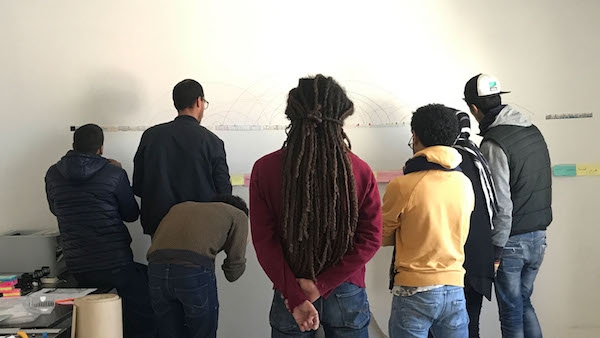
I am so thrilled to work with this incredible cohort: a group of philosophers and artists with a wide range of artistic and technical talents with passions that include history and memory, environmental causes and science, as well as social justice and art. There is no way I could have ever predicted how amazing the participants in this program would be. I am blown away daily by their commitment, inquisitiveness, and nuanced approaches to the profound questions that move them. Through them, I am seeing Casablanca.
---
The departure point of our studies is the idea that sensory and spatial mapping are interpretations and projections.
A space represented by a void is not necessarily empty.
A space replete with information is not necessarily accurate.
Information can be left out.
Information can be filled in.
Working definitions:
DATA: quantifiable information
MAP: data interpreted through space
EMPOWERMENT: knowing how generate to data to create maps that represent one’s own opinions, convictions, or knowledge.
Vast quantities of data are generated each second as we function in our digital environments. Patterns are found in this data and mapped according to preset priorities. In Rhetorical City, we look into what happens when we define the data we generate and choose the priorities by which data is analyzed.

In conversation with our tools, we choose how to deconstruct and reconstruct information, including information and images of ourselves. Using bristol paper and vinyl cutting machines, participants created layered, three-dimensional portraits of themselves. In converting their pixel-based portraits into vectors, the participants chose the level of resolution of their portraits. In a more abstract version of the exercise, Abdelilah selected very large-scale pixels of an image based on parts he liked or didn't like rather than based on color or tone. The product is a mask for the image that reveals or conceals personal preference.
To put these tools and processes into context, we looked at a survey of digital fabrication technologies and visited FabLab Casablanca to see some of them in action!

We discussed the reciprocal cycles of interpretation between ourselves and our tools — be they hand or digital drawing, an X-Acto knife, a vinyl cutter, a laser cutter, or a CNC router.
As pattern-finders and interpreters, how do individuals perceive, translate, and analyze?

To engage our bodies in the construction and relation of meaning, we started the program with a game of synesthetic exquisite corpse: by sharing sensory experiences collected throughout L'Uzine with one another, the participants created interpretive sequences, which then led to conversations about how we structure meaning and information through the creation and comparison of categories.

How do we create categories? How do we structure knowledge? How do we recognize the subjective in the process of categorization and how do we allow this recognition to liberate us from the pre-judgements and perceptions we have inherited? How do we display and validate our interpretations in relation to other interpretive systems that exist?
How do these corporeal experiences, memories, and categories impact our reading of our urban spaces?

Through quick mapping exercises, participants then connected their physical (sensory) categories and memories to their cities.
Otherwise invisible moments of experience, communication, and translation thus became conceptual trajectories through the city.
How can the connection and interpretation of corporeal and urban spaces help us understand, articulate, and propose action for critical social questions?

Research groups formed in the first week based on a quick ideation exercise. Using GoPros, audio recorders, and cell phones, the groups started to articulate societal questions of physical and economic access in public space.
Questions of accessibility, diversity, gender, environment, and economy were among those discussed and explored. In the process, different forms of transit to explore the life of spaces such as an unfinished highway, the bus, a skatepark, and major intersections.

After this initial research, groups formed based on ideation exercises exploring interests, identifying questions, and expanding skill sets. The social challenges that participants have taken on are large and complex, the products and processes proposed are eloquent and elegant; working with them to develop these is not only fascinating, but also fun!

American Arts Incubator is an initiative of the U.S. Department of State's Bureau of Educational and Cultural Affairs and is administered by ZERO1. The incubator in Morocco is produced in collaboration with U.S. Consulate General in Casablanca and L'Uzine.